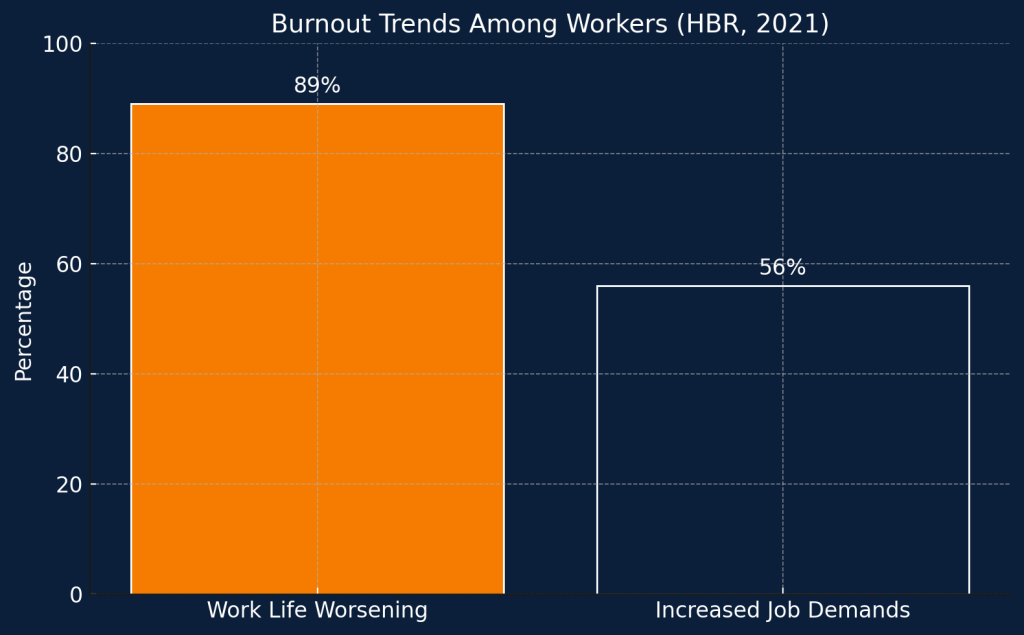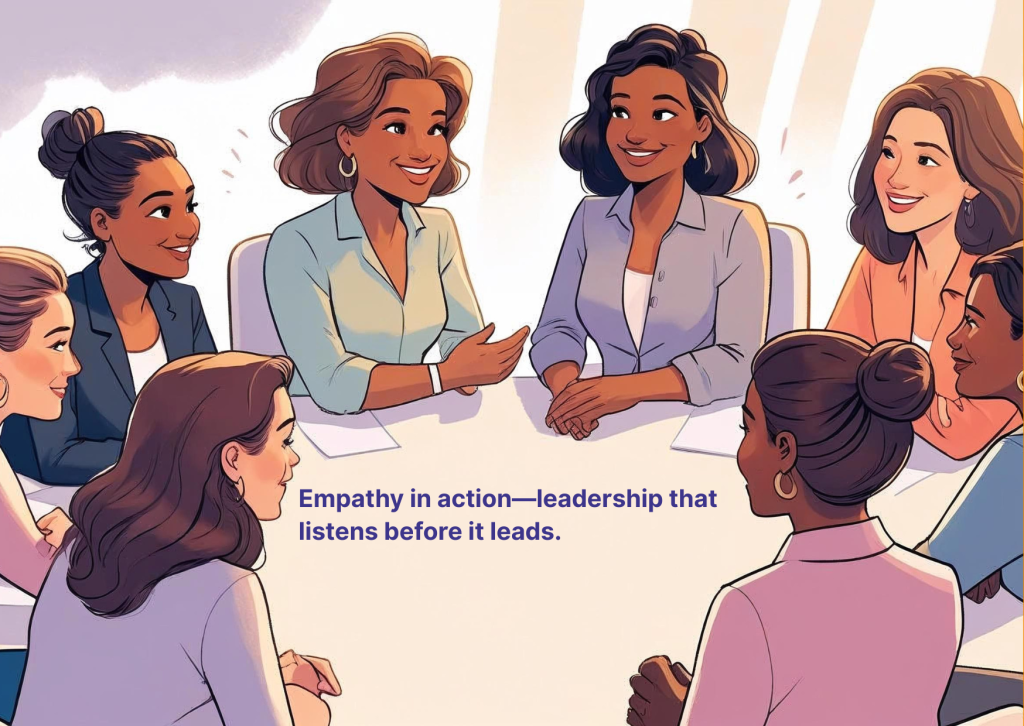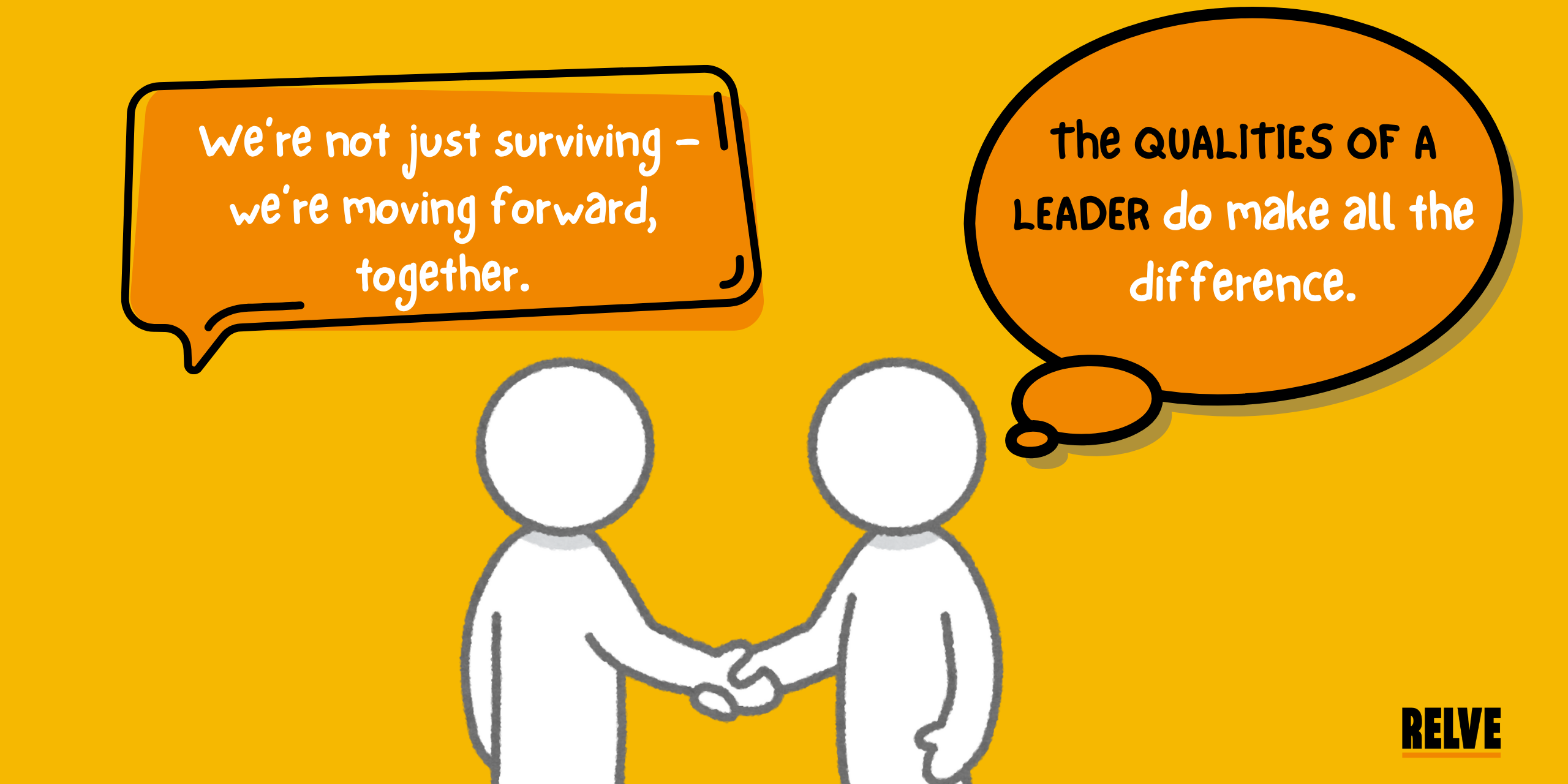Let’s be honest -we’re tired. Not just physically, but emotionally. The pressure to perform, the constant connectivity, and the unpredictable pace of disruption have left many leaders stretched thin. You’ve likely felt it too, the weight of guiding others while quietly trying to hold yourself together. In this kind of environment, the usual playbook no longer applies. We need to look inward and redefine the qualities of a leader that truly matter in times like these.
Burnout & Emotional Resilience
Today’s workplaces are increasingly remote and fast-paced. In the backdrop of a volatile and hybrid work climate, burnout is no longer an exception — it can happen to anyone.
According to Harvard Business Review, the toll on both employees and leaders is significant and rising. The data below highlights two major trends:


These charts underscore the urgency for emotionally intelligent, value-centered leadership.
Core Qualities of a Leader Today

Emotional Resilience and Empathy
When the team is exhausted and morale dips, it’s not KPIs or strategy decks that hold people together – it’s empathy that keeps them together. The most powerful thing we can do isn’t to fix every problem, but to be present.
Burnout is real, and the emotional well-being of a team starts with how safe they feel around their leader. Resilience isn’t just about bouncing back; it’s about staying human in the face of pressure. The qualities of a leader today must include the capacity to sit with discomfort, to listen without fixing, and to lead with heart.
Adaptability in the Face of Change
When the pandemic hit, everything changed. And then it changed again. The ground never really stopped shifting. That’s why one of the most crucial qualities we have had to strengthen is adaptability.
The qualities of a change leader aren’t just about managing projects – they’re about helping people feel anchored amid chaos. Embracing ambiguity, experimenting without fear of failure, and showing up as a calm force in a sea of uncertainty—these are no longer optional.
Strategic Vision and Long-Term Thinking

Guiding with Purpose and Possibility
It’s easy to get stuck in a reactive mode. But visionary leadership calls to rise above the noise and offer a long view. The qualities of a visionary leader involve more than ambition—they require deep listening, pattern recognition, and the courage to point to a horizon that others can’t yet see.
Vision isn’t just about setting direction – it’s about making meaning in moments when people crave hope. It’s what keeps your team going when the metrics say otherwise.
Visionary leaders don’t just chase trends – they interpret them. They step back when others rush in, ask “what if” when others say “not now,” and craft clarity from complexity.
Holding a vision is about giving people something to believe in, especially when progress feels slow or uncertain. When goals blur and stress peaks, it’s that deeper purpose that holds the team together. Vision is more than strategy – it’s shared meaning in motion.
Communication, Clarity, and Connection
Listening, Transparency, and Team Trust
Is communication just about talking? True leaders know it’s more about listening —and not just to what’s being said, but what’s not. In the remote world, primarily, connection depends on intentionality.
Building trust means being clear, honest, and, yes, vulnerable. The qualities of a leader here are rooted in openness and integrity. People don’t just want direction – they want to know that their leader sees them.
Connection isn’t built during status updates – it’s built in the pauses, in the follow-ups, in the willingness to ask “how are you really?” and wait for the answer.
Transparency is no longer a leadership bonus – it’s a requirement. Today, clarity doesn’t come from over-explaining; it comes from aligning words with values. When you lead with presence, people notice. And more importantly, they trust.
When communication is done right, it creates a sense of safety. When people feel safe, they innovate. They speak up. They collaborate. That’s the difference between teams that survive disruption and those that emerge stronger from it. Communication is not soft—it’s strategic.
What Are the Qualities of a Great Leader?
You’ve probably asked yourself this more than once: What are the qualities of a great leader? It boils down to five timeless traits:
- Integrity: Doing the right thing when no one’s watching. It’s the invisible backbone of leadership—the reason people believe in you when times get tough.
- Courage: Standing up when it’s easier to stay quiet. Courage is not about being fearless – it’s about doing what’s needed despite the fear.
- Accountability: Owning mistakes and modelling humility. A leader’s response to failure sets the tone for the team. When you take responsibility, you permit others to grow.
- Curiosity: Asking questions more than giving answers. The best leaders I know are learners first. They’re comfortable not knowing, and that humility fuels innovation.
- Compassion: Leading with love, not just logic. In moments of tension, a compassionate response creates loyalty that no bonus ever could.
These aren’t buzzwords. They’re daily decisions. And they show up in how you answer emails, how you respond under pressure, and how you treat the person with no power to help you. Outstanding leadership is built in small moments, not just big ones.
Developing the Leadership Qualities of a Leader
Daily Practices to Build Enduring Leadership Strength
No one is born with a fully developed leadership toolkit. We all grow through experience, mistakes, and reflection.
The leadership qualities of a leader rely on a few non-negotiables: journaling for self-awareness, regular feedback sessions (even when they’re challenging), and carving out time to think, not just act.
Personal rituals, such as walking without your phone, coaching sessions, or end-of-week reviews, help leaders stay grounded.
Leadership isn’t about having all the answers. It’s about cultivating the qualities that help you hold space for complexity and still move forward.
Which Leadership Qualities Do You Lean On Most?
Drag and drop each trait into the category where you think it belongs.
Essential Now
Timeless
Outdated
Conclusion: Leading with Humanity and Foresight
We’re not just managing teams anymore. We’re shaping cultures, influencing emotional ecosystems, and navigating uncharted terrain. The qualities of a leader today require more than vision and strategy – they demand humanity, clarity, and courage. If you’ve felt stretched, uncertain, or alone, you’re not failing. You’re evolving.
In this age of burnout and disruption, perhaps the most significant leadership act is to lead not from perfection, but from presence.
